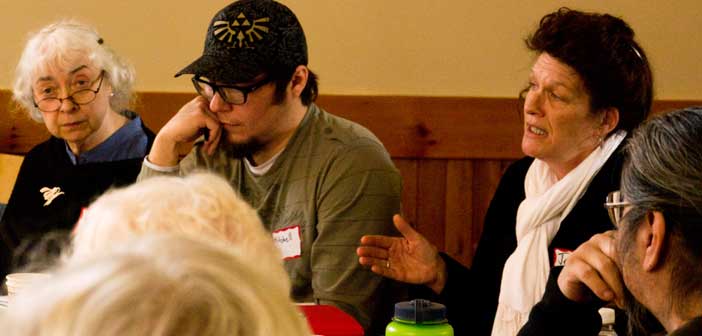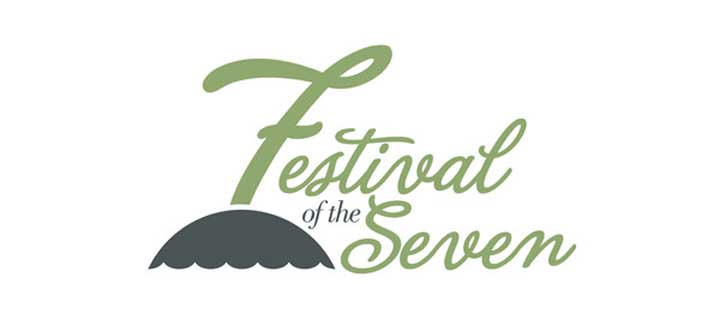KAGAWING—On a rare sunny day last week, a diverse group of more than three dozen artists, institutional, municipal and business representatives, funders and supporters of Island arts and culture met in a Cultural Direction Day organized by LAMBAC at the Park Centre in Kagawong. The meeting was the follow-up to last November’s Manitoulin Cultural Symposium and subsequent Action Day.
The agenda for last fall’s Symposium and Action Day originated in LAMBAC’s strategic plan for 2010-2015, which identified arts and culture as significant contributors to Manitoulin’s economic growth. From that impetus, and with Billings as the municipal lead, the Manitoulin Cultural Planning Project was approved for funding by the Ontario Ministry of Tourism, Culture and Sport in 2012, and a local steering committee set up in 2013 to plan the symposium, which drew over 120 attendees to the Manitoulin Hotel and Conference Centre on November 9. A cultural inventory was created and a website (manitoulinculture.ca) went live post-conference with an interactive map of cultural ‘assets’ and events listings; committees began work then to help give form and direction to the outcomes of the conference and to maximize the contributions of the Island’s vibrant arts and culture scene.
Participants in the Direction Day first heard a brief history of the project from Adam Hayden, LAMBAC’s industrious intern. Reports were presented from the committees that had worked all winter to explore ways to increase the impact of the arts and cultural sector on the Island economy and on artists’ work and lives, and to look at practical structures and ideas for the creation of an arts and cultural council. Artist Michael Cywink suggested that the room’s tables and chairs be reconfigured into a circle, immediately turning the space into one of ‘participatory democracy’ and greatly improving communications for the rest of the day.
Committee chairs Alex Baran, Ashley Whyte, Kate Thompson and Sophie Edwards shared committee efforts aimed at developing marketing ideas and organizational structural and sustainability strategies, fostering creative networking, and creating an effective liaison with the Manitoulin Tourism Association. Early on, there had been agreement among committees to support the MTA’s own cultural strategy, specifically the MTA’s Festival of a Thousand Skills slated for the last weekend of September.
[pullquote]According to the MTA, the new festival, which will incorporate the former Taste of Manitoulin food festival, will be a “three-day skill-sharing experience with more than a hundred micro workshops and demonstrations of a wide variety of community and family knowledge and cultural traditions.”[/pullquote]
According to the MTA, the new festival, which will incorporate the former Taste of Manitoulin food festival, will be a “three-day skill-sharing experience with more than a hundred micro workshops and demonstrations of a wide variety of community and family knowledge and cultural traditions.” Sophie Edwards, executive director of 4elements Living Arts (most Manitoulin cultural workers wear many hats but for this article, they are described by their most familiar occupation) says, “liaison with the MTA is important as the MTA mandate is to provide the broad-based marketing to attract tourists to the Island, although not all cultural organizations and activities are tourism-based. The ‘external’ marketing of the MTA and the ‘internal’ communications work of the arts council would create a holistic approach to communicating the Island’s cultural activities.” The workings of that collaboration between the group and the MTA will be defined further in the coming weeks; as a first step, a ‘skills inventory’ is in the process of being fleshed out by the planning group.
Alex Baran, multi-faceted cultural worker and facilitator, presented his committee’s proposals for the creation of the Manitoulin Arts and Cultural Council, including a mission statement and organizational plan for a board and sub-committees. Based on seven core cultural disciplines or sectors identified as performing, visual, digital, literary and culinary arts as well as crafts and heritage, it was proposed (and approved) that there be seven representatives from First Nations and seven representatives from non-First Nations on the council’s board.
General Manager of LAMBAC, Mary Nelder, reflects that, in the planning process, “the sharing of ideas between people from both our founding cultures and various artistic disciplines was great to see and left us, the organizers, feeling very hopeful.” The sector descriptions will be broadened or re-named as appropriate as work proceeds, in the name of wide inclusivity, and the mission statement will be refined as required. Ms. Nelder goes on to say: “the most important ongoing development is the creation of a Manitoulin Arts and Cultural Council (MACC). When this council is populated with representatives from all the creative disciplines from both the First Nation and non-First Nation communities, it will be in a position to carry on the planning and coordination work that has begun. It will be able to maintain the website and inventories that have been created, and keep the lines of communication open amongst all the diverse elements of this sprawling, multi-limbed beast that is the Manitoulin cultural community. Finally, it will have the authority to speak for this community with one voice to the funders and the three levels of government regarding the important role that culture plays in our economic well-being and establishing our sense of place, which ultimately is what draws us here and keeps us here…It’s been clear to me that the timing was right for this project. That doesn’t always happen with community economic development but when it does it’s a beautiful thing.”
Following a light, tasty lunch catered by Kagawong’s Main Street Bakery and Café during which the buzz of animated conversations filled the room, participants heard from Ron Berti, head of the MTA, who defined culture as “the way we live our lives”—in other words, culture encompasses everything we do creatively. He presented new eye-catching poster designs for the MTA’s 2014 tourism campaigns that capture the ‘Manitoulin feeling’ in imaginative new ways and that aim to extend the marketing reach of Manitoulin this year and in future. Bonita Taibossigai, tour development officer for the Great Spirit Circle Trail, outlined the GSCT’s inspiring ‘experiences’ programs, an impressive Island model for success in cultural tourism.
Joel Gauthier, regional advisor for the Ministry of Tourism, Culture and Sport, and Françoise Nadon, community economic development officer for FedNor (Industry Canada), described criteria and ‘tips for success’ in funding applications that were eagerly received by the audience.
The day’s business continued with discussions of the board nomination process, which is open to arts and culture workers listed in the cultural inventory, and includes self-nomination. Further proposals were put forward that outlined recommendations for work to be undertaken in the first and second years of the new Council in the categories of shared activities, capacity building (skills inventory), communications, organizational funding and events. The first orders of business for year one are to define collaboration with the MTA on the Festival of a Thousand Skills, seek funding to hire an arts and cultural coordinator to manage communications, among other tasks, continue website development and maintenance, and plan an event for year two in a different timeframe from the Festival of a Thousand Skills, in order to enhance and expand Manitoulin’s cultural offerings into the ‘shoulder seasons.’ An intern will also work within LAMBAC to support the board and the coordinator’s efforts.
Mary Nelder sums up the work of the planning group in the ongoing process as “a reflection of the fact that the people on those committees truly have their ears to the ground and are committed to finding solutions that work for local artists and artisans, not borrowing a plan from somewhere else and manipulating it to fit our reality.”
Sophie Edwards adds, “As small, rural and Northern communities, we need to engage our creativity to rethink our economies, build our resilience and create healthy communities. We need to think about interconnections, sharing resources, co-learning and co-teaching. We may not be able to do it the way we’ve done until now, and we may not be able to rely on the typical centralized meetings and structures we know so well.”
Artist Sophie Pheasant-Jones underlined that a critical element in the success of the process has been “the continual involvement and support by the artists and the organizations.”
Alex Baran outlines the future of the council and its initiatives as an “ongoing process”—a dynamic one, with nominations and election of the council’s board to take place within a month or so, and matters of governance, legal status, priorities and longer term issues to consider following the creation of the Manitoulin Arts and Cultural Council.
Judging from the enthusiasm and engagement of the participants in the thoughtful and disciplined process of the Cultural Planning Project since last November, all of Manitoulin stands to benefit from the positive impacts of this leading-edge development on the cultural landscape.





